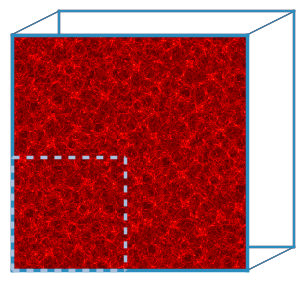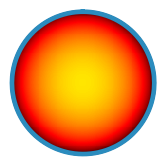Data Guide | Millennium
This simulation is good for ...
- Modelling galaxies with stellar mass above ~10^8.5 Msun
- Probing scales up to 500 h^-1 Mpc (without repetition)
- General-purpose galaxy evolution studies with the likes of the SDSS
- Detailed structural stellar, HI, and H2 properties of galaxies (with Dark SAGE)
Overview
At the time of its publication in 2005, the Millennium simulation was the largest ΛCDM cosmological N-body simulation ever run. It has since become the standard simulation for constructing galaxies with semi-analytic models and is still actively used for research today. The simulation was performed with GADGET2, which uses a `Tree Particle Mesh' algorithm to compute gravitational forces. Further details of the simulation can be found in the paper by Springel et al. (2005).
Relative size
- Box length: 500 h^-1 Mpc
The volume relative to an all-sky survey out to z=0.05:

Mass resolution
- Particle mass: 8.6 × 10^8 h^-1 Msun
- Gravitational softening: 5 h^-1 kpc
- Number of particles: 2160^3
- Number of snapshots to z=0: 64

Cosmology
The cosmological parameters of the Millennium simulation are based on WMAP-1 data (Spergel et al. 2003) and the 2dF Galaxy Redshift Survey (Colless et al. 2001).
- Ω_M = 0.25
- Ω_Λ = 0.75
- Ω_b = 0.045
- σ_8 = 0.9
- n = 1
- h = 0.73
Haloes
Haloes and subhaloes were identified using the popular SUBFIND code. The merger trees of these haloes were built using LHALOTREE, which is described in the Supplementary Information of the Millennium paper. A minimum of 20 particles was required for a (sub)halo to be included in the trees.